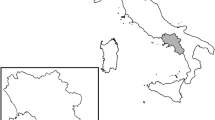Abstract
Hair tubes are efficient for sampling shrews and potentially important for sampling Sorex minutus, which is poorly sampled with other methods such as live trapping. We tested the effect of aperture size, bait, and position and type of sticky strip in hair tubes on the detection of S. minutus hairs. The optimum S. minutus hair tube design has high specificity for S. minutus (hairs are 12 times more likely to be from S. minutus than from other species), easily constructed and suitable for use in large-scale surveys. Between the end of July and middle of September 2008 we repeatedly surveyed 46 sites twice with a transect of 20 S. minutus hair tubes. Occupancy of S. minutus was higher in hedgerow sites (0.92) than grassland (0.59) and woodland sites (0.42). Relative activity-density was estimated from models allowing abundance-induced heterogeneity in detection probability and was also higher in hedgerow sites (1.75) than grassland (1.23) and woodland sites (0.72). Relative activity-density is a function of abundance and movement and hence should be interpreted with caution but is a valuable parameter to estimate from data on presence or absence of a species at a site. From our data we recommend that surveys are carried before the end of August, in which case three surveys per site at up to 120 sites per habitat (depending on habitat and start date) are necessary to obtain precise estimates of site occupancy. Site occupancy should be quantified as a relevant parameter alongside abundance when conducting indirect surveys of mammals and relative activity-density should also be considered.
Similar content being viewed by others
References
Battersby, J. (Ed.), 2005. UK Mammals: Species Status and Population Trends. JNCC/Tracking Mammals Partnership, Peterborough.
Battersby, J.E., Greenwood, J.J.D., 2004. Monitoring terrestrial mammals in the UK: past, present and future, using lessons from the bird world. Mammal Rev. 34, 3–29.
Burnham, K.P., Anderson, D.R., 1998. Model Selection and Inference. A Practical Information — Theoretic Approach. Springer-Verlag, New York.
Churchfield, S., 1990. The Natural History of Shrews. Christopher Helm, London.
Flowerdew, J.R., Shore, R.F., Poulton, S.M.C., Sparks, T.H., 2004. Live trapping to monitor small mammals in Britain. Mammal Rev. 34, 31–50.
Gelman, A., Su, Y.-S., Yajima, M., Hill, J., Pittau, M.G., Kerman, J., Zheng, T., 2009. arm: Data Analysis Using Regression and Multilevel/Hierarchical Models. R Package version 1.2–7.
Gurnell, J., Flowerdew, J.R., 2006. Live Trapping Small Mammals: A Practical Guide. Mammal Society, London.
Harris, S., Yalden, D.W., 2004. An integrated monitoring programme for terrestrial mammals in Britain. Mammal Rev. 34, 157–167.
MacKenzie, D.I., Nichols, J.D., Lachman, G.B., Droege, S., Royle, J.A., Langtimm, C.A., 2002. Estimating site occupancy rates when detection probabilities are less than one. Ecology 83, 2248–2255.
MacKenzie, D.I., Nichols, J.D., Royle, J.A., Pollock, K.H., Hines, J.E., Bailey, L.L., 2005. Occupancy Estimation and Modeling: Inferring Patterns and Dynamics of Species Occurrence. Elsevier, San Diego.
Mackenzie, D.I., Royle, J.A., 2005. Designing occupancy studies: general advice and allocating survey effort. J. Appl. Ecol. 42, 1105–1114.
McKelvey, K.S., Pearson, D.E., 2001. Population estimators with sparse data: the role of estimators versus indices revisited. Can. J. Zool. 79, 1754–1765.
Mortelliti, A., Boitani, L., 2008. Evaluation of scent-station surveys to monitorthe distribution of three European carnivore species (Martes foina, Meles meles, Vulpes vulpes) in a fragmented landscape. Mamm. Biol. 73, 287–292.
Pocock, M.J.O., Jennings, N., 2006. Use of hair tubes to survey for shrews: new methods for identification and quantification of abundance. Mammal Rev. 36, 299–308.
Pocock, M.J.O., Jennings, N., 2007. Testing biotic indicator taxa: the sensitivity of insectivorous mammals and their prey to the intensification of lowland agriculture. J. Appl. Ecol. 45, 151–160.
R Development Core Team, 2009. R: A Language and Environment for Statistical Computing. R Foundation for Statistical Computing, Vienna, Austria. http://www.R-project.org.
Royle, J.A., Nichols, J.D., 2003. Estimating abundance from repeated presence-absence data or point counts. Ecology 84, 777–790.
Royle, J.A., Nichols, J.D., Kéry, M., 2005. Modelling occurrence and abundance of species when detection is imperfect. Oikos 110, 353–359.
Shore, R.F., Myhill, D.G., Lhotsky, R., Mackenzie, S., 1995. Capture success for pygmy and common shrews (Sorex minutus and S. araneus) in Longworth and pitfall traps on up and b anket bog. J. Zoo. 237, 657–662.
Slade, N.A., Blair, S.M., 2000. An empirical test of using counts of individuals captured as indices of population size. J. Mammal. 81, 1035–1045.
Stanley, T.R., Royle, J.A., 2005. Estimating site occupancy and abundance using indirect detection indices. J. Wildlife Manage. 69, 874–883.
Thomas, C.F.G., Brown, N.J., Kendall, D.A., 2006. Carabid movement and vegetation density: implications for interpreting pitfall trap data from split-field trials. Agr. Ecosyst. Environ. 113, 51–61.
White, G.C., 2005. Correcting wildlife counts using detection probabilities. Wildlife Res. 32, 211–216.
White, G.C., Burnham, K.P., 1999. Program MARK: survival estimation from populations of marked animals. Bird Study 46, S120–S139.
Author information
Authors and Affiliations
Corresponding author
Rights and permissions
About this article
Cite this article
Pocock, M.J.O., Bell, S.C. Hair tubes for estimating site occupancy and activity-density of Sorex minutus. Mamm Biol 76, 445–450 (2011). https://doi.org/10.1016/j.mambio.2011.02.002
Received:
Accepted:
Published:
Issue Date:
DOI: https://doi.org/10.1016/j.mambio.2011.02.002




